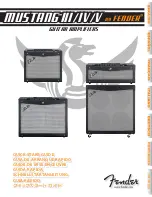
- Cosmic Ampworks
®
- The Ultimate Harley Benton GA15 Mod Kit- Version 1.4 - 200127
© 2020 -
2
Dedicated to the Advancement of Stellar Tone!
1.
Adding a grid leak resistor to V2A (oddly, the first preamp tube is numbered V2 in the schematic (p.9, p.27)
and on the circuit board; p.10), to make sure the correct bias is maintained at all times.
2.
Replacing the cathode bias resistors of V2A and V2B (p.10), for higher gain and a warmer sound.
3.
Replacing the cathode bypass capacitor of V2B (p.11). This will allow more bass frequencies to pass
through the tube, resulting in a fuller, less boxy sound.
Then there is a slightly more involved mod:
4.
Installing a gain control between the V2A and V2B (p.11). In the stock GA15, R4 and R5 together form a
voltage divider with an output voltage of only 1.66% of the input - a total waste of gain. As
we’re
aiming to
replace the active op-amp-based tonestack with a purely tube-based tonestack, we
’re going to
need
every bit of gain available. Therefore, the stock voltage divider is replaced here by a 500k gain potmeter.
With its gain set to the max, it allows 100% of the signal from V2A to reach the grid of V2B (and with less
than maximum gain, it works as a variable voltage divider). With a very strong input signal at V2A, V2B
might even get overdriven - perfectly fine if that is what you want, but a clean signal should still be an
option - dialing back the gain is the solution then. So, the primary goal of the added gain control is being
able to dial in maximum clean headroom, rather than obtaining a crunchy, distorted sound (with maximum
gain,
you’ll probably just get a slight crunch at best
). Dialing in more gain will also make your tone
harmonically richer and fatter, even before getting distorted. Less gain results in a somewhat more jangly
tone.
The most challenging mods (some of which are optional):
5.
Assembling and installing a James tonestack and volume control on the back of three potmeters (p.13).
This enables creating a purely tube-based signal path (no op-amps), with a 2-band passive EQ (treble and
bass). Due to the low insertion loss of the James tonestack, no additional tubes are needed to boost the
signal. Wiring the tonestack may be quite challenging!
6.
Wiring a DC power supply for the preamp heater filaments and rearrange the heater wiring (p.16). This will
largely eliminate the GA15
’s hum problem
. As the active op-amp based tonestack was removed (with mod
5.), the DC power supply that powered the TL072 op-amp ICs can be used to power the pre-amp tubes
–
which are most sensitive to hum. Generally, heaters of (preamp) tubes are wired in parallel, from a 6.3V AC
supply. Here, we will wire them in series, from 12V DC.
7.
Install a presence and negative feedback control
–
optional (p.21). With the presence control, some more
aggressive highs can be dialed in. Adding negative feedback will result in a more modern, flatter sound.
8.
Rerouting the wiring for the power tube heater supply
–
optional (p.25). This is an optional mod; very
likely, mod 6 already resulted in a very quiet amp. When the mods were developed, power and preamp
tubes were rerouted all at once, so it is difficult to tell the effect of only rerouting the power amp heater
wiring. Normally, in a push-pull power amp, most of the hum in the opposing tubes cancels out.
Before starting, a few words on safety.
If you have not been trained to work with high voltages, then please
have a qualified amp technician modify your amp. Cosmic Ampworks does not recommend you to start
working on the GA15 amplifier yourself
if you don’t have the right skills and knowledge
!
For those
with
the
appropriate skills, a number of safety warning are included below.



































